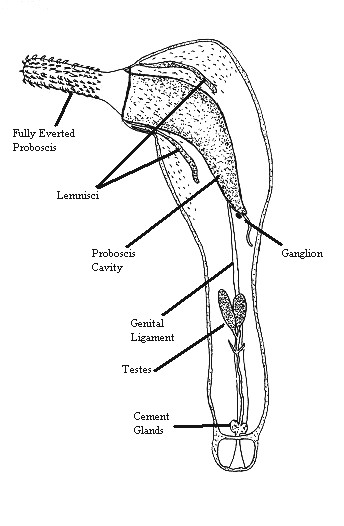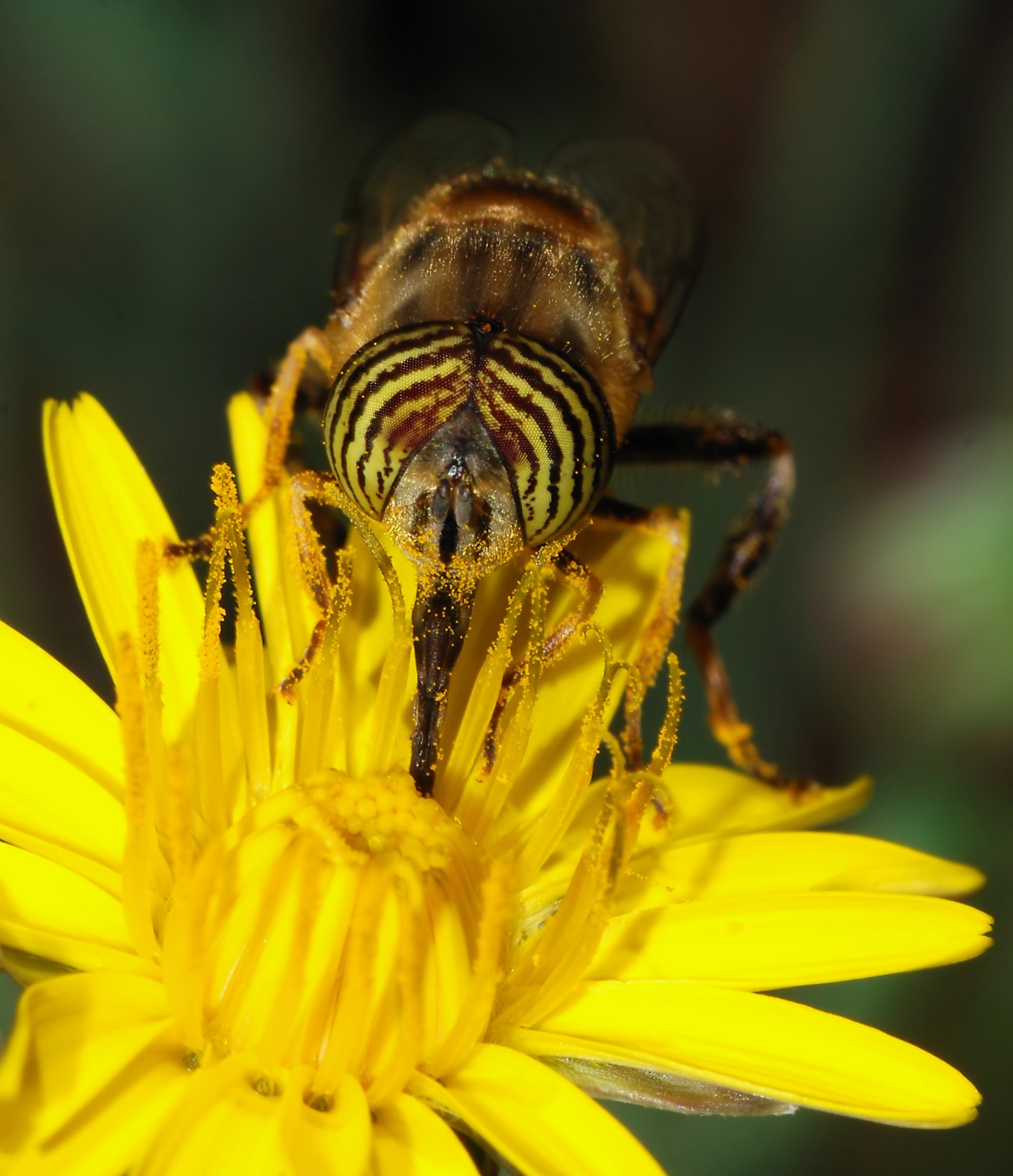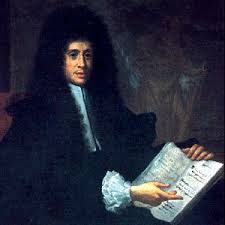|
Acanthocephalans
Acanthocephala ( Greek , ' 'thorn' + , ' 'head') is a group of parasitic worms known as acanthocephalans, thorny-headed worms, or spiny-headed worms, characterized by the presence of an eversible proboscis, armed with spines, which it uses to pierce and hold the gut wall of its host. Acanthocephalans have complex life cycles, involving at least two hosts, which may include invertebrates, fish, amphibians, birds, and mammals. About 1,420 species have been described. The Acanthocephala were long thought to be a discrete phylum. Recent genome analysis has shown that they are descended from, and should be considered as, highly modified rotifers. This unified taxon is sometimes known as Syndermata, or simply as Rotifera, with the acanthocephalans described as a subclass of a rotifer class Hemirotatoria. History The earliest recognisable description of Acanthocephala – a worm with a proboscis armed with hooks – was made by Italian author Francesco Redi (1684). In 1771 ... [...More Info...] [...Related Items...] OR: [Wikipedia] [Google] [Baidu] |
Archiacanthocephala
Archiacanthocephala is a class within the phylum of Acanthocephala. They are parasitic worms that attach themselves to the intestinal wall of terrestrial vertebrates, including humans. They are characterised by the body wall and the lemnisci (which are a bundle of sensory nerve fibers), which have nuclei that divide without spindle formation, or the appearance of chromosomes, or it has a few amoebae-like giant nuclei. Typically, there are eight separate cement glands in the male, which is one of the few ways to distinguish the dorsal and ventral sides of these organisms. Taxonomy Genetic data are not available for the genus ''Apororhynchus'' in public databases, and ''Apororhynchus'' has not been included in Phylogenetics, phylogenetic analyses thus far due to insufficiency of Morphology (biology), morphological data. However, the lack of features such as an absence of a muscle plate, a wikt:midventral, midventral wikt:longitudinal, longitudinal muscle, wikt:lateral, lateral recep ... [...More Info...] [...Related Items...] OR: [Wikipedia] [Google] [Baidu] |
Eoacanthocephala
Eoacanthocephala is a class of parasitic worms, within the phylum Acanthocephala. They feed on any aquatic cold-blooded creature such as turtles and fish. Their proboscis spines are arranged radially, with no protonephridia, and with persistent ligament sacs in female. The only reliable way to identify the group is that they only have one cement gland. This is a primitive characteristic and hence the name. The class contains 2 orders Order, ORDER or Orders may refer to: * A socio-political or established or existing order, e.g. World order, Ancien Regime, Pax Britannica * Categorization, the process in which ideas and objects are recognized, differentiated, and understood * H ...: * Gyracanthocephala Van Cleave, 1936 * Neoechinorhynchida Southwell and Macfie, 1925 References *Robert L. Usinger; Storer. 1951. General Zoology. Sixth edition. McGraw-Hill, Inc. Page-437.ITIS - Report: Eoacanthocephala".''www.itis.gov''. Retrieved 2022-10-15. Acanthocephalans { ... [...More Info...] [...Related Items...] OR: [Wikipedia] [Google] [Baidu] |
Proboscis
A proboscis () is an elongated appendage from the head of an animal, either a vertebrate or an invertebrate. In invertebrates, the term usually refers to tubular arthropod mouthparts, mouthparts used for feeding and sucking. In vertebrates, a proboscis is an elongated nose or snout. Etymology First attested in English in 1609 from Latin , the latinisation (literature), latinisation of the Ancient Greek (), which comes from () 'forth, forward, before' + (), 'to feed, to nourish'. The plural as derived from the Greek is , but in English the plural form ''proboscises'' occurs frequently. Invertebrates The most common usage is to refer to the tubular feeding and sucking organ of certain invertebrates such as insects (e.g., Insect mouthparts#Proboscis, moths, butterflies, and mosquitoes), worms (including Acanthocephala, Nemertea, proboscis worms) and gastropod molluscs. Acanthocephala The Acanthocephala, the thorny-headed worms or spiny-headed worms, are characterized by the pr ... [...More Info...] [...Related Items...] OR: [Wikipedia] [Google] [Baidu] |
Palaeacanthocephala
Palaeacanthocephala ("ancient thornheads") is a class within the phylum Acanthocephala. The adults of these parasitic platyzoans feed mainly on fish, aquatic birds and mammals. This order is characterized by the presence of lateral longitudinal lacunar canals and a double-walled proboscis receptacle. The nuclei of the hypodermis (outer layer of skin) are fragmented and the males have two to seven cement glands, unlike their relatives the Archiacanthocephala, which always have eight. There are three orders in the class Palaeacanthocephala: * Echinorhynchida Southwell and Macfie, 1925 * Heteramorphida Amin and Ha, 2008 * Polymorphida Polymorphida are an order of thorny-headed worms (phylum Acanthocephala). The adults of these parasitic platyzoans feed mainly on fish and aquatic birds. This order contains 5 families:Huston, D. C., Cribb, T. H., & Smales, L. R. (2020). Molecu ... Petrochenko, 1956 References Acanthocephalans {{Acanthocephalan-stub ... [...More Info...] [...Related Items...] OR: [Wikipedia] [Google] [Baidu] |
Polyacanthocephala
Polyacanthorhynchidae is a family of parasitic worms from the phylum Acanthocephala. It contains a single genus ''Polyacanthorhynchus''. Taxonomy Phylogenetic analysis has found that polyacanthocephala represents a distinct class of acanthocephalans. Species There are four species in the genus Polyacanthorhynchus. * ''Polyacanthorhynchus caballeroi'' Diaz-ungria and Rodrigo, 1960 The complete genome of the mitochondria has been determined. ''P. caballeroi'' infect South American caimans. * ''Polyacanthorhynchus echiyensis'' * ''Polyacanthorhynchus kenyensis'' Schmidt and Canaris, 1967 ''P. kenyensis'' has been found infecting three freshwater teleosts: the Blue spotted tilapia (''Oreochromis leucostictus''), the Redbelly tilapia (''Tilapia zillii''), and the Largemouth bass (''Micropterus salmoidein'') in Lake Naivasha, Kenya. Samples were found in the liver of ''Tilapia'' and ''Orechromis'' and free in the body cavity in ''Micropterus''Description of morphology available ... [...More Info...] [...Related Items...] OR: [Wikipedia] [Google] [Baidu] |
Corynosoma Wegeneri
''Corynosoma'' is a genus of parasitic worms belonging to the family Polymorphidae. The genus has almost cosmopolitan distribution. Species: *''Corynosoma alaskensis'' *''Corynosoma australe'' *''Corynosoma beaglense'' *''Corynosoma bullosum'' *''Corynosoma cameroni'' *''Corynosoma caspicum'' *''Corynosoma cetaceum'' *''Corynosoma curilense'' *''Corynosoma enhydri'' *''Corynosoma erignathi'' *''Corynosoma evae'' *''Corynosoma falcatum'' *''Corynosoma gibsoni'' *''Corynosoma hamanni'' *''Corynosoma hannae'' *''Corynosoma magdaleni'' *''Corynosoma pseudohamanni'' *''Corynosoma rauschi'' *''Corynosoma reductum'' *''Corynosoma semerme'' *''Corynosoma septentrionale'' *''Corynosoma shackletoni'' *''Corynosoma simile'' *''Corynosoma stanleyi'' *''Corynosoma strumosum'' *''Corynosoma validum'' *''Corynosoma ventronudum'' *''Corynosoma villosum'' *''Corynosoma wegeneri'' References Polymorphidae Acanthocephala genera {{acanthocephalan-stub ... [...More Info...] [...Related Items...] OR: [Wikipedia] [Google] [Baidu] |
Syndermata
Syndermata is a clade of animals that, in some systems, is considered synonymous with Rotifera. Older systems separate Rotifera and Acanthocephala as different phyla, and group them both under Syndermata., p. 788ff. – see particularly p. 804 This clade is placed in the Platyzoa. Phylogeny Phylogenetic analysis of the 18S ribosomal gene has revealed that the Acanthocephala, formerly considered a separate phylum are most closely related to the rotifers. They are possibly closer to the two rotifer classes Bdelloidea and Monogononta than to the other class, Seisonidea, producing the names and relationships shown in the cladogram below. A study of the gene order in the mitochondria suggests that Seisonidea and Acanthocephala are sister clades and that the Bdelloidea are the sister clade to this group. This has since been corroborated by the discovery of a fossil stem-group In phylogenetics, the crown group or crown assemblage is a collection of species composed of the ... [...More Info...] [...Related Items...] OR: [Wikipedia] [Google] [Baidu] |
Francesco Redi
Francesco Redi (18 February 1626 – 1 March 1697) was an Italians, Italian physician, naturalist, biologist, and poet. He is referred to as the "founder of experimental biology", and as the "father of modern parasitology". He was the first person to challenge the theory of spontaneous generation by demonstrating that maggots come from eggs of fly, flies. Having a doctoral degree in both medicine and philosophy from the University of Pisa at the age of 21, he worked in various cities of Italy. A rationalist of his time, he was a critic of verifiable myths, such as spontaneous generation. His most famous experiments are described in his Masterpiece, magnum opus ''Esperienze intorno alla generazione degl'insetti'' (''Experiments on the Generation of Insects''), published in 1668. He disproved that vipers drink wine and could break glasses and that their venom was poisonous when ingested. He correctly observed that snake venoms were produced from the fangs, not the gallbladder, as wa ... [...More Info...] [...Related Items...] OR: [Wikipedia] [Google] [Baidu] |
Cambridge University Press
Cambridge University Press was the university press of the University of Cambridge. Granted a letters patent by King Henry VIII in 1534, it was the oldest university press in the world. Cambridge University Press merged with Cambridge Assessment to form Cambridge University Press and Assessment under Queen Elizabeth II's approval in August 2021. With a global sales presence, publishing hubs, and offices in more than 40 countries, it published over 50,000 titles by authors from over 100 countries. Its publications include more than 420 academic journals, monographs, reference works, school and university textbooks, and English language teaching and learning publications. It also published Bibles, runs a bookshop in Cambridge, sells through Amazon, and has a conference venues business in Cambridge at the Pitt Building and the Sir Geoffrey Cass Sports and Social Centre. It also served as the King's Printer. Cambridge University Press, as part of the University of Cambridge, was a ... [...More Info...] [...Related Items...] OR: [Wikipedia] [Google] [Baidu] |
Joseph Koelreuter
Joseph is a common male name, derived from the Hebrew (). "Joseph" is used, along with " Josef", mostly in English, French and partially German languages. This spelling is also found as a variant in the languages of the modern-day Nordic countries. In Portuguese and Spanish, the name is "José". In Arabic, including in the Quran, the name is spelled , . In Kurdish (''Kurdî''), the name is , Persian, the name is , and in Turkish it is . In Pashto the name is spelled ''Esaf'' (ايسپ) and in Malayalam it is spelled ''Ousep'' (ഔസേപ്പ്). In Tamil, it is spelled as ''Yosepu'' (யோசேப்பு). The name has enjoyed significant popularity in its many forms in numerous countries, and ''Joseph'' was one of the two names, along with ''Robert'', to have remained in the top 10 boys' names list in the US from 1925 to 1972. It is especially common in contemporary Israel, as either "Yossi" or "Yossef", and in Italy, where the name "Giuseppe" was the most common m ... [...More Info...] [...Related Items...] OR: [Wikipedia] [Google] [Baidu] |
Philipp Ludwig Statius Müller
Philipp Ludwig Statius Müller (25 April 1725 – 5 January 1776) was a German zoologist. Statius Müller was born in Esens, and was a professor of natural science at Erlangen. Between 1773 and 1776, he published a German translation of Linnaeus's '' Natursystem''. The supplement in 1776 contained the first scientific classification for a number of species, including the dugong, guanaco, potto, tricolored heron, umbrella cockatoo, red-vented cockatoo, and the enigmatic hoatzin. He was also an entomologist. Müller died in Erlangen. He is not to be confused with Salomon Müller (1804–1864), also an ornithologist, or with Otto Friedrich Müller Otto Friedrich Müller, also known as Otto Friedrich Mueller (2 November 1730 – 26 December 1784) was a Denmark, Danish natural history, naturalist and scientific illustrator. Biography Müller was born in Copenhagen. He was educated for the ch .... Works *Statius Müller, P. L. 1776. ''Des Ritters Carl von Linné Königlich ... [...More Info...] [...Related Items...] OR: [Wikipedia] [Google] [Baidu] |
Middle Jurassic
The Middle Jurassic is the second Epoch (geology), epoch of the Jurassic Period (geology), Period. It lasted from about 174.1 to 161.5 million years ago. Fossils of land-dwelling animals, such as dinosaurs, from the Middle Jurassic are relatively rare, but geological formations containing land animal fossils include the Forest Marble Formation in England, the Kilmaluag Formation in Scotland,British Geological Survey. 2011Stratigraphic framework for the Middle Jurassic strata of Great Britain and the adjoining continental shelf: research report RR/11/06 British Geological Survey, Keyworth, Nottingham. the Calcaire de Caen of France, the Daohugou Beds in China, the Itat Formation in Russia, the Tiouraren Formation of Niger, and the Isalo III Formation of western Madagascar. Rocks of the Middle Jurassic were formerly (until about 1980s) in Europe called ''Dogger'' or ''Brown Jurassic''. Paleogeography During the Middle Jurassic Epoch, Pangaea began to separate into Laurasia and Gond ... [...More Info...] [...Related Items...] OR: [Wikipedia] [Google] [Baidu] |




